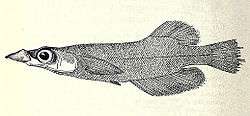Adrianichthys kruyti
| Duckbilled buntingi | |
|---|---|
 | |
| Scientific classification | |
| Kingdom: | Animalia |
| Phylum: | Chordata |
| Class: | Actinopterygii |
| Order: | Beloniformes |
| Family: | Adrianichthyidae |
| Genus: | Adrianichthys |
| Species: | A. kruyti |
| Binomial name | |
| Adrianichthys kruyti M. C. W. Weber, 1913 | |
Adrianichthys kruyti (the duckbilled buntingi or duck-bill Poso minnow) is a critically endangered species of ricefish that is endemic to Lake Poso, Sulawesi, Indonesia.[1][2] It was discovered by Max Wilhelm Carl Weber on his Siboga Expedition to Indonesia.[3]
Description
The duckbilled buntingi is on average about 11 cm long[4] but can grow as long as 16 cm in length.[5] Despite their size they were sometimes caught by local fishermen and eaten.[4] The duckbilled buntingi has 14–16 dorsal soft rays and 24–25 anal soft rays.[5] Its defining characteristic, which separates Adrianichthys from all other members of the family, Adrianichthyidae, is its peculiar "duck-bill," or overhanging upper jaw.[5] It has eyes that protrude above the dorsal profile of its head and are visible from below. It also has 14–16 rays in dorsal fin and about 75 scales in lateral rows.[5]
Conservation
Some local fisherman living near Lake Poso attribute the duckbilled buntingi's dramatic decrease in population to the massive eruption of Colo Volcano on Una-Una Island in Tomini Bay in 1983.[4] This is unlikely to be the case. Instead most scientists believe the human introduction of the predatory fishes including snakehead, Channa striata, and tilapia, Oreochromis mossambicus, most likely led to their present conservation status.
Conservation status
The duckbilled buntingi's status on the IUCN Red List changed from endangered to critically endangered in 1996.[1] Historically the species was not closely monitored so it is unclear when the species population began to decrease. It was listed as endangered until 1996 when Harrison and Stiassny published an article claiming that the duckbilled buntingi could be extinct, which led to the World Conservation Union changing the status of that species from endangered to critically endangered species on the IUCN Red List.[1] The matter has been referred to the relevant Specialist Group for a decision.[1] Harrison and Stiassny believe that one of the possible causes for the extinction or decline in the A. kruyti population was an introduced disease or parasite.[2]
Conservation history
- 1988 Endangered (IUCN Conservation Monitoring Centre 1988)
- 1990 Endangered (IUCN 1990)
- 1994 Endangered (Groombridge 1994)
- 1996 Critically Endangered (IUCN 1996)
Ecology
The duckbilled buntingi only live in Lake Poso which is a freshwater body with a pH range: 7.5 – 8.5.[5] Although little is known about their reproductive tendencies, their predators, or who they prey on, one of their closest relatives, the Xenopoecilus poptae, may serve to give us some indication of the duckbilled buntingi's biology.[4] X. poptae was said to have congregated in great shoals of 12–15 m deep from November to January.[4] X. poptae reproductive systems are atypical they are believed to have voided eggs that hatched on contact with the lake water.[4]
References
- 1 2 3 4 Kottelat, M. 1996. "Adrianichthys kruyti". In: IUCN 2006. 2006 IUCN Red List of Threatened Species. <www.iucnredlist.org>. Accessed 22 April 2007.
- 1 2 Harrison, Ian J. and Melanie L. J. Stiassny (1999). "The Quiet Crisis," Plenlum Publishers: New York
- ↑ Thompson, D'Arcy Wentworth. "Max Wilhelm Carl Weber, 1852-1937." 'Obituary Notices of Fellows of the Royal Society.' The Royal Society: 1938.
- 1 2 3 4 5 6 Whitten et al.: "One or More Extinctions from Sulawesi, Indonesia?". Conservation Biology, 1987
- 1 2 3 4 5 Cruz, Tess. "Adrianichthys kruyti: Duckbilled Buntingi". www.fishbase.org. Accessed April 23, 2007.
